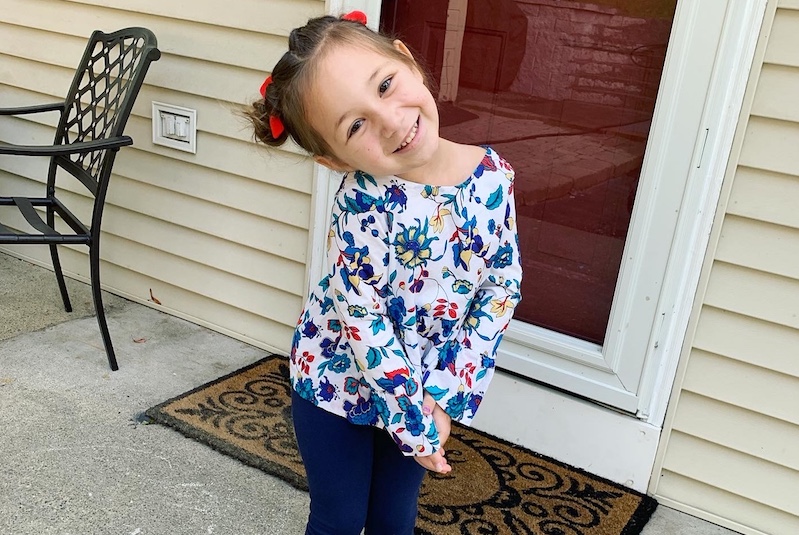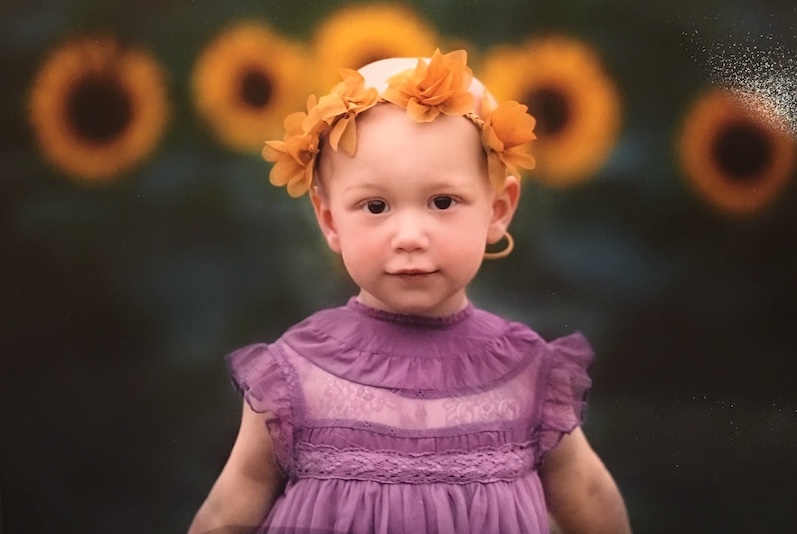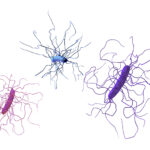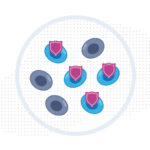Charlee: Bouncing back after neuroblastoma treatment

Call it mother’s intuition, but leading up to her daughter’s cancer diagnosis, Erica Jensen knew something wasn’t right. At just 10 months, Charlee had started walking, and since taking her first steps the excited toddler was constantly exploring the world around her. Then, at around 15 months, something changed.
It wasn’t obvious at first — an extra stumble here or an unsure step there — but as the weeks passed it became clear something wasn’t right. Charlee wasn’t sleeping through the night anymore, and then she wasn’t walking at all.
Initially, her symptoms went undiagnosed, which frustrated her parents Erica and Kyle. Ultimately, they brought Charlee to the emergency room when her symptoms worsened. It was there she had an MRI, a test Erica remembers vividly as the moment “our lives changed forever.”
The MRI revealed a tumor in her right adrenal gland, one of two small triangular-shaped glands located atop the kidneys, and additional involvement of her bone-marrow. Charlee was diagnosed with high-risk, metastatic (stage M) neuroblastoma — a cancer that arises in immature nerve cells. She was also found to have opsoclonus-myoclonus syndrome (OMS), a rare disorder that affects the nervous system. OMS includes symptoms such as sudden muscle spasms, irregular, rapid eye movement, loss of developmental milestones, and trouble walking. It is rare for a patient to have both high-risk neuroblastoma and OMS.
“I was in shock. My body went numb,” recalls Erica. “No parent should ever have to hear their child has cancer.”
Charlee needed treatment right away, and she was placed under the care of Dr. Steven DuBois and Dr. Whitney Eng, oncologists at Dana-Farber/Boston Children’s Cancer and Blood Disorders Center.

Bouncing back after treatment
To treat her neuroblastoma, Charlee underwent intensive treatment including several cycles of chemotherapy (which commonly causes nausea, weight loss, and fever), surgery to remove the tumor, two consecutive autologous stem cell transplants, radiation, and antibody therapy.
As Dr. Eng describes, “The treatment for high-risk neuroblastoma is one of the most intense treatments a patient can go through. A family’s life gets turned upside down in an instant, and they spend much of their time between Boston Children’s and the Jimmy Fund Clinic.” Dr. Eng warned the young family the side effects could be severe, and that Charlee might not feel like herself for a long time.
It turned out neither cancer nor the treatments, could keep her down for long. After receiving steroids and an IV medication called intravenous immunoglobulin (IVIG), Charlee began walking again. Charlee turned heads each day bouncing out of bed and heading down to the playroom. Despite everything she was going through, Charlee remained upbeat, her attitude inspiring everyone around her.
“She’s a unicorn,” says Dr. Eng. “It is rare to see. Charlee, and her family rose to this impossible task and did amazing with these very intense treatments.”
“She paved the way for us, waking up with a smile on her face every day,” adds Erica. “She made sure everyone knew she was going to get through this, and our job was to fight with her.”
Since finishing therapy in 2018, Charlee, who is now almost 5, has had no evidence of disease, and the OMS has not returned.
A supportive care team
Throughout Charlee’s experience, Erica remembers acts of kindness from everyone they met at Dana-Farber/Boston Children’s. Whether it was a cook offering Charlee a special French toast breakfast (her favorite) after every treatment, or the programs at the Jimmy Fund Clinic, Erica says it’s the people at Dana-Farber/Boston Children’s who make the place special.
“There is always someone who can help you with anything you’re going through,” says Erica. “They make a world of a difference and we are so thankful we were able to come here.”
Today Charlee is singing, dancing, and filling up the home with arts and crafts. She’s also become a big sister to Lylah, whom Erica and Kyle welcomed in last June. For the couple, watching the sisters play together has helped them stay optimistic about the future.
“We know we aren’t alone. There is always hope out there,” adds Erica. “Thanks to Dana-Farber we aren’t living in fear anymore, but instead enjoying all the good moments.”
This post originally ran on the Dana-Farber Cancer Institute’s blog, Insight.
Learn more about the Dana-Farber/Boston Children’s Cancer and Blood Disorders Center.
Related Posts :
-

Exposing a tumor’s antigens to enhance immunotherapy
Successful immunotherapy for cancer involves activating a person’s own T cells to attack the tumor. But some tumors have ...
-

Combining CAR-T cells and inhibitor drugs for high-risk neuroblastoma
Chimeric antigen receptor (CAR)-T cell therapy is a potent emerging weapon against cancer, altering patients’ T cells so they ...
-

Could a GI bug’s toxin curb hard-to-treat breast cancer?
Clostridium difficile can cause devastating inflammatory gastrointestinal infections, with much of the damage inflicted by a toxin the bug produces. ...
-

Making immunotherapy safe for AML
Acute myeloid leukemia (AML), the second most common leukemia in children, is hard to treat and has a five-year survival ...





